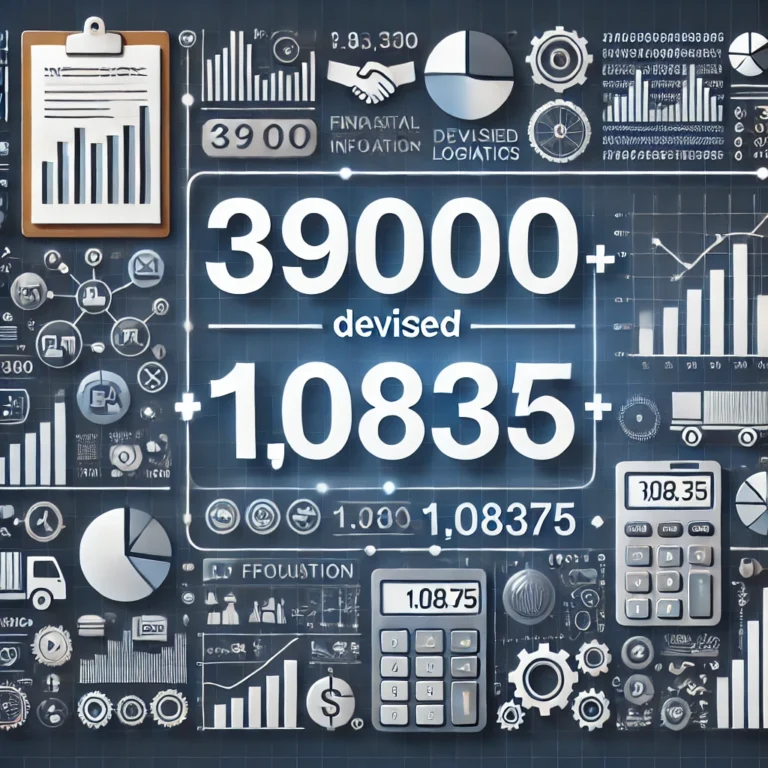In various fields, including finance, engineering, science, and business, accurate conversions and calculations play a crucial role in decision-making and data analysis. Understanding how to convert or solve for values accurately can provide insightful data for both small and large operations. In this article, we will explore the calculation of 39000/1.08375 in detail, including the context, applications, and practical implications of this calculation.
Breaking Down the Calculation: 39000/1.08375
The mathematical operation of dividing 39000/1.08375 is straightforward but may have specific contextual applications that can be significant. Here’s how the calculation is set up:39000÷1.0837539000 \div 1.0837539000÷1.08375
To find the exact result, we perform the division, giving us a precise answer which is essential in scenarios where accuracy is paramount. The result is as follows:
Calculation Result
After dividing 39000/1.08375, we get:39000÷1.08375=35987.7639000 \div 1.08375 = 35987.7639000÷1.08375=35987.76
The result of 35987.76 has numerous potential applications across various industries, providing insights or final values needed in practical scenarios.
Practical Applications of the Division
1. Financial Analysis and Investment Calculations
In finance, accurate conversions and calculations are fundamental, especially when evaluating returns, costs, and ratios. A calculation such as 39000/1.08375 might be used to adjust figures for inflation, adjust for currency exchange rates, or understand effective costs in investment planning. For example:
- Currency Adjustments: When analyzing the impact of currency changes on foreign investments, dividing an amount by an exchange rate, such as 1.08375, might reveal the local currency equivalent or the adjusted value in the target currency.
- Inflation Adjustment: Calculating adjusted figures by dividing them with an inflation or deflation factor helps ensure that all figures reflect current or historical purchasing power accurately.
2. Engineering and Scientific Calculations
In engineering and scientific research, values often need to be converted to account for unit adjustments, scale modifications, or ratio calculations. A division like 39000/1.08375 could be representative of:
- Unit Conversion: Converting measurements from one unit to another often requires division by a factor. The exact value resulting from this operation can allow engineers and scientists to align their calculations with specific units of measurement.
- Efficiency Ratios: If 39000 represents an initial capacity, dividing it by an efficiency factor like 1.08375 can reveal a realistic output or adjusted value, which is critical in design and resource management.
3. Business Operations and Logistics
Companies engaged in logistics, inventory, or supply chain management often rely on precise calculations to determine costs, set pricing, or evaluate distribution efficiency. A calculation of 39000/1.08375 can support:
- Cost Adjustments: If 39000 represents a cost or budget, dividing it by a specific factor can yield a cost per unit or adjusted budget, necessary for optimizing financial plans.
- Inventory Valuation: Inventory adjustments may require dividing a bulk figure by factors like 1.08375 to get a precise valuation or adjusted quantity.
Understanding Decimal Precision in Division
When working with decimal values, such as the result 35987.76, ensuring precision is essential. Decimal values help improve accuracy, especially in sectors where rounding errors could lead to significant losses or inaccuracies. Decimal precision allows:
- Improved Accuracy: Provides exact figures necessary for reports, proposals, or other high-stakes documents.
- Efficient Resource Management: Businesses or engineers can allocate resources accurately, avoiding excesses or shortages.
- Enhanced Forecasting: Accurate decimals enable better forecasting in areas like budgeting, financial analysis, and production planning.
In calculations that involve currency, for example, decimals help in reaching exact amounts that influence purchasing power and profitability.
Common Scenarios for Using Division in Industry
1. Adjusting for Tax and Markup in Sales
For sales and marketing departments, knowing how to calculate a base value or adjusted amount is crucial for determining prices. For instance, if 39000 represents a post-tax or marked-up price, dividing it by a markup factor like 1.08375 helps derive the initial pre-tax amount. This is common in:
- Sales Price Adjustments: Ensuring prices reflect proper markup percentages.
- Net Profit Calculations: Back-calculating to understand net profit when presented with gross profit and tax figures.
2. Conversion of Workforce Efficiency
For operations where human resource efficiency is measured, dividing by a factor representing output variability helps reveal realistic figures, especially in forecasting or budget assessments. If 39000 represents total expected output, dividing by 1.08375 would give an adjusted figure that accounts for variability in workforce productivity, crucial for:
- Labor Cost Estimation: Accurately budgeting for workforce costs.
- Resource Allocation: Allocating workforce based on efficiency-adjusted figures.
3. Academic and Educational Contexts
In education, precise calculations are necessary for academic research, grading, and analysis. Understanding how to interpret results like 39000/1.08375 can assist in areas like statistical analysis and data interpretation.
Benefits of Using Detailed Conversion Calculations
1. Clarity in Data Interpretation
Accurate division results help clarify data, enabling organizations to make data-driven decisions. When results are clear and well-defined, stakeholders can understand figures without confusion, supporting effective decision-making processes.
2. Streamlined Financial Management
In financial management, division calculations allow accountants and financial analysts to determine critical values like break-even points, cost per unit, and adjusted revenue. Dividing by specific factors enables organizations to adjust their financial figures, enhancing budget accuracy and financial forecasting.
3. Efficient Resource Allocation
Whether in finance, logistics, or engineering, resource allocation is essential. Dividing by relevant factors helps ensure that resources like time, money, and personnel are used effectively, improving overall efficiency and reducing waste.
Conclusion
Understanding the practical applications of dividing 39000/1.08375 goes beyond basic math—it’s about interpreting results accurately and applying them in real-world situations. From finance and engineering to logistics and education, calculations such as these form the backbone of data-driven decision-making, efficient resource management, and compliance with regulatory standards. By implementing accurate conversions, organizations can optimize their operations, reduce errors, and ensure they’re always working with the most precise data possible.




